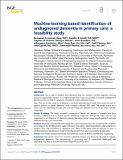Files in this item
Machine-learning based identification of undiagnosed dementia in primary care : a feasibility study
Item metadata
| dc.contributor.author | Jammeh, Emmanuel A. | |
| dc.contributor.author | Carroll, Camille B. | |
| dc.contributor.author | Pearson, Stephen W. | |
| dc.contributor.author | Escudero, Javier | |
| dc.contributor.author | Anastasiou, Athanasios | |
| dc.contributor.author | Zhao, Peng | |
| dc.contributor.author | Chenore, Todd | |
| dc.contributor.author | Zajicek, John | |
| dc.contributor.author | Ifeachor, Emmanuel | |
| dc.date.accessioned | 2018-06-27T08:30:06Z | |
| dc.date.available | 2018-06-27T08:30:06Z | |
| dc.date.issued | 2018-06-12 | |
| dc.identifier | 253425361 | |
| dc.identifier | ad8c9710-f20f-42b4-ad99-9c5ab0668733 | |
| dc.identifier | 85074425970 | |
| dc.identifier.citation | Jammeh , E A , Carroll , C B , Pearson , S W , Escudero , J , Anastasiou , A , Zhao , P , Chenore , T , Zajicek , J & Ifeachor , E 2018 , ' Machine-learning based identification of undiagnosed dementia in primary care : a feasibility study ' , BJGP Open , vol. 2 , no. 2 , bjgpopen18X101589 . https://doi.org/10.3399/bjgpopen18X101589 | en |
| dc.identifier.issn | 2398-3795 | |
| dc.identifier.other | ORCID: /0000-0003-3481-825X/work/64034669 | |
| dc.identifier.uri | https://hdl.handle.net/10023/14651 | |
| dc.description | This article presents independent research commissioned by the National Institute for Health Research (NIHR) under its Programme Grants for Applied Research Programme (grant reference number: RP-PG-0707-10124). Financial support from the UK Engineering and Physical Sciences Research Council (EPSRC) (grant reference number: EP/M006301/1) and the EU Horizon 2020 (EU H2020) Marie Skłodowska-Curie Innovative Training Networks (grant reference number: 721281) is also gratefully acknowledged. | en |
| dc.description.abstract | Background : Up to half of patients with dementia may not receive a formal diagnosis, limiting access to appropriate services. It is hypothesised that it may be possible to identify undiagnosed dementia from a profile of symptoms recorded in routine clinical practice. Aim : The aim of this study is to develop a machine learning-based model that could be used in general practice to detect dementia from routinely collected NHS data. The model would be a useful tool for identifying people who may be living with dementia but have not been formally diagnosed. Design & setting : The study involved a case-control design and analysis of primary care data routinely collected over a 2-year period. Dementia diagnosed during the study period was compared to no diagnosis of dementia during the same period using pseudonymised routinely collected primary care clinical data. Method : Routinely collected Read-encoded data were obtained from 18 consenting GP surgeries across Devon, for 26 483 patients aged >65 years. The authors determined Read codes assigned to patients that may contribute to dementia risk. These codes were used as features to train a machine-learning classification model to identify patients that may have underlying dementia. Results: The model obtained sensitivity and specificity values of 84.47% and 86.67%, respectively. Conclusion: The results show that routinely collected primary care data may be used to identify undiagnosed dementia. The methodology is promising and, if successfully developed and deployed, may help to increase dementia diagnosis in primary care. | |
| dc.format.extent | 13 | |
| dc.format.extent | 677383 | |
| dc.language.iso | eng | |
| dc.relation.ispartof | BJGP Open | en |
| dc.subject | NHS data | en |
| dc.subject | Primary care | en |
| dc.subject | GP practice | en |
| dc.subject | Machine learning | en |
| dc.subject | Read code | en |
| dc.subject | Dementia | en |
| dc.subject | RC0321 Neuroscience. Biological psychiatry. Neuropsychiatry | en |
| dc.subject | E-NDAS | en |
| dc.subject.lcc | RC0321 | en |
| dc.title | Machine-learning based identification of undiagnosed dementia in primary care : a feasibility study | en |
| dc.type | Journal article | en |
| dc.contributor.institution | University of St Andrews. School of Medicine | en |
| dc.contributor.institution | University of St Andrews. Cellular Medicine Division | en |
| dc.identifier.doi | 10.3399/bjgpopen18X101589 | |
| dc.description.status | Peer reviewed | en |
This item appears in the following Collection(s)
Items in the St Andrews Research Repository are protected by copyright, with all rights reserved, unless otherwise indicated.

